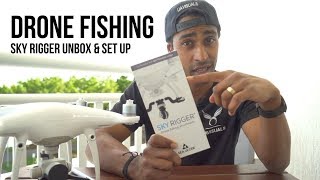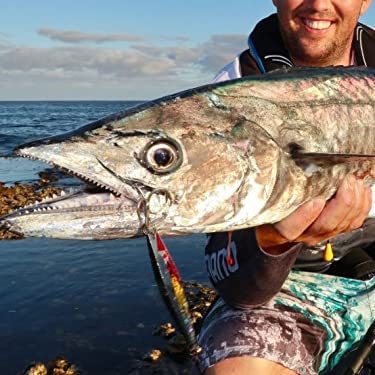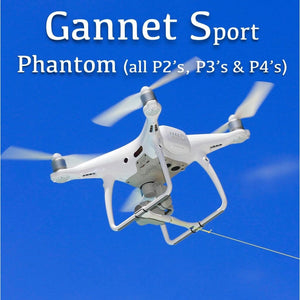
If you are an avid fisherman and live in Australia, you can now use a drone to get an aerial view of the waters around your property. A drone can have many features such as an angle adjustable camera and GPS positioning system. You can also purchase fishing lines, which are stable and safe. The SKY RIGGER drone is one such example.
The drone fishing line SKY RIGGER can be used for spotting fish.
The SKY RIGGER flexible fishing line system allows you to fish from the sky with minimum effort. It has two rotating leg clamps, which can be mounted to many drone models. The release mechanism features a bayonet-style connection, and a cam lock arm that allows you to quickly open the line clamps. Sky RIGGER doesn't require batteries unlike other drones. This drone can take all kinds of fishing techniques and is safe.
The SKY RIGGER includes an automatic release system for fish that strike your fly. The line can be manually released by either your rod or hand. This feature is available for all models of the SKY RIGGER. It is strongly recommended that you first purchase a Phantom 3 before you purchase the new SKY RIGGER. Here are some pros and cons to the new line system.
It can be set up to release a payload mechanically
A drone's mechanical payload mechanism is one of its most important features. Many of them allow anglers to quickly and easily release their fishing line. However, some models do not have a release mechanism. Instead, the user must "yank" the fishing line to release the drone from the line. This can be a tedious process, especially for those who don't feel comfortable using their hands to release it.

Another important feature of the drone's payload release system is its size. The drone's payload should be capable to release its line when the fish strikes. This method is not easy to use. You can't just pull the fish up and let it go. Many have had positive experiences with the DJI Phantom. However, this technology has not yet reached the level of fishing drones that are available on the market.
It features a GPS positioning device
Rippton, an Australian and Dutch joint venture, specializes in technology-oriented fish products. Its goal is improve anglers' success by creating products that enhance the fishing experience. Rippton’s Mobula drone comes with a GPS position system and remote release. The Mobula has the ability to hold bait at surface, provide resistance for kite clips, as well as being environmentally friendly.
It is light at 3 pounds and can take off for 18 minutes. The high-tech GPS system allows it to be controlled up to 2,000 feet away. It is capable of flying at 1000 meters (or half a kilometer) range and has intelligent flight modes. The point of interest feature allows it to take high-quality photos of its surroundings. Its high-resolution camera allows you to get great views of fish.
It has a failsafe feature
Aerokontiki's fisherman drone has a failsafe function: It monitors battery levels and releases fishing line when necessary. In case of battery failure, it will land back on dry ground to continue its mission. It has industrial-grade flight controls and can operate wherever it goes without recalibration. This drone is also waterproof, so you can use it even in the most difficult water spots.

FAQ
How do you travel with a drone?
Drones are becoming more and more popular for personal and professional use. They are used for video, filming aerial mapping, search &rescue, and many other purposes. Recently, the FAA approved new regulations for drones, including requirements for registration, licensing and pilot training. These changes will help ensure that drones remain safe for everyone involved.
How high can you fly a drone without a license?
The FAA does not limit the height of a drone. However, you must register your unmanned aircraft system (UAS), which includes the registration numbers, model name and weight, size, serialnum, manufacturer's name and date manufactured.
Is it possible to fly a helicopter while driving?
Driving a drone is dangerous, as it could cause an accident or crash into another vehicle. You may also run into pedestrians and other animals. Additionally, hitting power lines, trees or buildings could cause damage to your car.
Statistics
- According to industry research from ZipRecruiter , there are 10 cities where the typical salary for a Drone Pilot job is above the national average. (dronesgator.com)
- According to the multiple listing service (MLS), houses and apartments with drone photographs are up to 68 percent more likely to sell than those without pictures. (thedroneu.com)
- With the top 10% making over $100/h and the bottom 10% making as low as $10/h. (dronesgator.com)
External Links
How To
How to Fly Drones With Beginners
A drone is a remotely-controlled aircraft that is used for aerial photography and surveillance. Drones are a technology that has been around since World War II. DJI's Phantom series of quadcopters was the first to be commercially used. From beginner-friendly drones such as Parrot AR Drone 2.0 through professional-grade multirotor craft like DJI Mavic Pro, many types have been available.
There are many options for flying a drone.
-
Remote control – This technique uses a control device attached directly to your hands that allows you steer the drone around its flight path. There are two main types, On/Off switches (like radios) and joysticks.
-
Manual Control - Using a smartphone app, this method allows users to remotely operate the drone via GPS coordinates. The app will provide instructions and help you to locate the drone.
-
Autonomous Flight - This method involves leaving the piloting duties to the drone itself. It's basically flying autonomously without any human intervention. It must have a builtin camera, sensors capable of taking images and data to enable autonomous flight.
-
Triggered Flight - This method is similar to manual control, except the pilot manually sets up a preprogrammed route, and the drone follows that route until it reaches the endpoint. Once the programmed route has been completed, the drone returns to the base automatically.
-
Landing Gear – Some drones are equipped with landing gear, which allows them to safely land if they lose power during flight.
-
Goggles - Some pilots wear goggles to protect themselves from debris while operating.
-
Camera - Some drones can be equipped with cameras which enable you to capture photos from the sky.
-
Obstacles - Some drones can be equipped with obstacle avoidance systems that prevent them from crashing into obstacles.
-
Speed - Drones can reach speeds up to 40 mph.
-
Battery Life - Most drones can last between 20 minutes to 3 hours, depending on how much power you're using.
-
Range - Some drones can travel upto 30 miles depending on their models.
-
Power source - Some drones require an external power source; others work off internal batteries.
-
Weight - Some drones are lighter than others, while some models can weigh as much as 4 pounds.
-
Size - Drones come in many sizes, from small gadgets that fit in one's hands to large craft that weigh more than 50 lbs.
-
Price - All drones fall within a specific price range, from high-end models that can cost thousands of dollars to lower-cost options starting at $100.